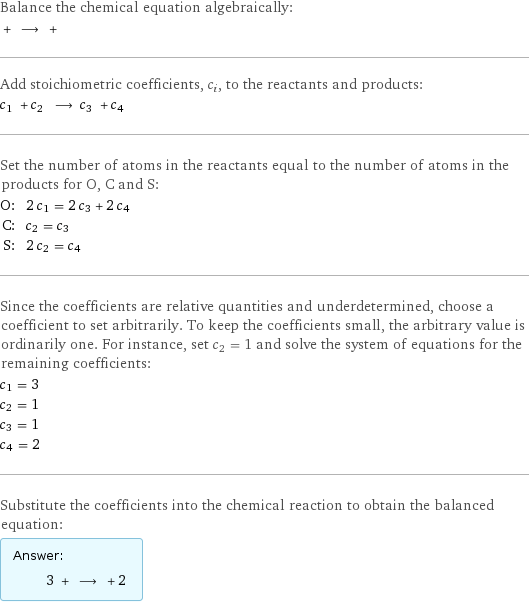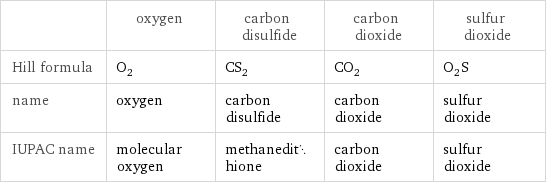Input interpretation

oxygen + carbon disulfide ⟶ carbon dioxide + sulfur dioxide
Balanced equation

Balance the chemical equation algebraically: + ⟶ + Add stoichiometric coefficients, c_i, to the reactants and products: c_1 + c_2 ⟶ c_3 + c_4 Set the number of atoms in the reactants equal to the number of atoms in the products for O, C and S: O: | 2 c_1 = 2 c_3 + 2 c_4 C: | c_2 = c_3 S: | 2 c_2 = c_4 Since the coefficients are relative quantities and underdetermined, choose a coefficient to set arbitrarily. To keep the coefficients small, the arbitrary value is ordinarily one. For instance, set c_2 = 1 and solve the system of equations for the remaining coefficients: c_1 = 3 c_2 = 1 c_3 = 1 c_4 = 2 Substitute the coefficients into the chemical reaction to obtain the balanced equation: Answer: | | 3 + ⟶ + 2
Structures

+ ⟶ +
Names

oxygen + carbon disulfide ⟶ carbon dioxide + sulfur dioxide
Reaction thermodynamics
Gibbs free energy

| oxygen | carbon disulfide | carbon dioxide | sulfur dioxide molecular free energy | 231.7 kJ/mol | 64.6 kJ/mol | -394.4 kJ/mol | -300.1 kJ/mol total free energy | 695.1 kJ/mol | 64.6 kJ/mol | -394.4 kJ/mol | -600.2 kJ/mol | G_initial = 759.7 kJ/mol | | G_final = -994.6 kJ/mol | ΔG_rxn^0 | -994.6 kJ/mol - 759.7 kJ/mol = -1754 kJ/mol (exergonic) | | |
Chemical names and formulas

| oxygen | carbon disulfide | carbon dioxide | sulfur dioxide Hill formula | O_2 | CS_2 | CO_2 | O_2S name | oxygen | carbon disulfide | carbon dioxide | sulfur dioxide IUPAC name | molecular oxygen | methanedithione | carbon dioxide | sulfur dioxide